The Critical Role of Printing Inspection Systems in Enhancing Document Security
In an era marked by a surge in counterfeiting and fraudulent activities, the significance of security features in printed materials cannot be overstated. From currency and passports to identification cards and important documents, ensuring authenticity is paramount. This article explores the pivotal role of advanced printing inspection systems in verifying security features, discussing their importance in preventing unauthorized replication.

Why Choose Printing Inspection Systems Integrated in Security Feature Verification
The Evolution of Security Features
Traditionally, security features relied on intricate designs, watermarks, and specialized inks. However, technology advances have given rise to highly sophisticated security measures, including invisible elements such as holograms, microprinting, UV inks, and color-shifting inks. To combat the evolving methods of counterfeiters, printing technology has adapted, incorporating these advanced security features.
The Challenge of Counterfeiting
Counterfeiters continually seek ways to replicate these advanced security measures, posing a significant challenge to authorities and organizations tasked with safeguarding printed materials. In this landscape, printing inspection systems become indispensable, providing a reliable means of verifying the presence and correct implementation of intricate security measures.
The Role of Printing Inspection Systems
Printing inspection systems are sophisticated technologies designed to inspect printed materials with extreme precision. Employing optical, mechanical, and electronic components, these systems play a crucial role in ensuring the authenticity of security features through:
Detection of Defects: Identifying flaws, irregularities, or deviations from the intended design, including missing or incorrectly placed security elements.
Verification of Security Features: Detecting the presence of specific security features and ensuring accurate reproduction by comparing printed materials to predefined standards.
Authentication of Color and Inks: Assessing color accuracy and the authenticity of inks, especially crucial for anti-counterfeit features relying on color-shifting or UV-responsive inks.
Fine Detail Inspection: Excelling at inspecting intricate details, including complex patterns, watermarks, or hidden images that are difficult to assess with the naked eye.
Real-time Monitoring: Offering real-time monitoring during the printing process, enabling immediate identification and correction of issues to reduce the likelihood of compromised materials entering circulation.

Key Benefits of Printing Inspection Systems in Security Feature Verification
Reduced Risk of Unauthorized Replication: Scrutinizing printed materials for adherence to specific security standards reduces the risk of unauthorized replication, ensuring document integrity.
Prevention of Security Feature Omissions: Preventing unintentional omissions of security features, guaranteeing that every printed item contains the necessary security elements.
Consistent Quality Control: Maintaining a consistent level of quality control in security printing by ensuring security features meet predefined standards across all printed materials.
Adherence to Industry Standards and Regulations: Ensuring compliance in industries where specific security printing standards are mandated, especially crucial for government-issued documents.
Minimized Risk of Fraud: Accurate verification of security features minimizes the risk of fraudulent activities, including attempts to alter or replicate documents for unauthorized purposes.
Increased Trust in Document Integrity: Instilling confidence in the integrity of printed materials for institutions, businesses, and government entities, crucial for maintaining public trust.
Efficient Resolution of Printing Issues: Real-time monitoring facilitates the immediate identification and resolution of security feature issues, minimizing potential impacts on overall document authenticity.
Protection Against Document Tampering: Contributing to protection against document tampering by ensuring tamper-evident elements and security features are intact and correctly implemented.
Enhanced Overall Security: Elevating the overall security of printed materials, making it more challenging for individuals or entities to compromise document authenticity through unauthorized replication or alteration.
Conclusion
In the dynamic landscape of security printing, the role of printing inspection systems is critical. These cutting-edge technologies not only confirm the presence and accuracy of security features but also contribute to ongoing efforts to ensure the authenticity of printed materials. The collaboration of innovative security features and advanced inspection systems remains essential in staying ahead of counterfeiters, safeguarding the integrity of critical documents and valuable items.
- Art
- Causes
- Crafts
- Dance
- Drinks
- Film
- Fitness
- Food
- Παιχνίδια
- Gardening
- Health
- Κεντρική Σελίδα
- Literature
- Music
- Networking
- άλλο
- Party
- Religion
- Shopping
- Sports
- Theater
- Wellness


